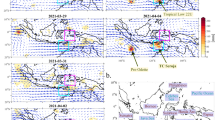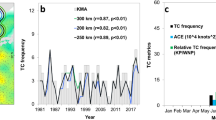Abstract
IN his article on the birth and death of cyclones (London Meteorological Office, Geophysical Memoirs, No. 19, 1922) Sir Napier Shaw makes the interesting suggestion that the shearing of the head of a tropical cyclone with reference to its foot, by difference of velocity at different levels in the air which carries it, might cause its dissolution. If the hypothesis that the movement of a cyclone is due to its being embedded in a flowing current of air is correct, it will of course be admitted that if there is a considerable gradient of wind upwards, positive or negative, then there must be a continual shearing of the cyclone and the shearing must either be continually countered by the cyclone, or it must die. But the question is, whether there are occasions when a cyclone has to face such a strong vertical gradient of wind, and if there are, what vertical gradient a cyclone can stand and continue to live? With regard to the first point, from an examination of the symmetry of temperature and pressure Sir Napier Shaw remarks:
This is a preview of subscription content, access via your institution
Access options
Subscribe to this journal
Receive 51 print issues and online access
$199.00 per year
only $3.90 per issue
Buy this article
- Purchase on Springer Link
- Instant access to full article PDF
Prices may be subject to local taxes which are calculated during checkout
Similar content being viewed by others
Author information
Authors and Affiliations
Rights and permissions
About this article
Cite this article
BANERJI, S. Vertical Change of Wind and Tropical Cyclones. Nature 111, 668–669 (1923). https://doi.org/10.1038/111668b0
Issue Date:
DOI: https://doi.org/10.1038/111668b0
Comments
By submitting a comment you agree to abide by our Terms and Community Guidelines. If you find something abusive or that does not comply with our terms or guidelines please flag it as inappropriate.



